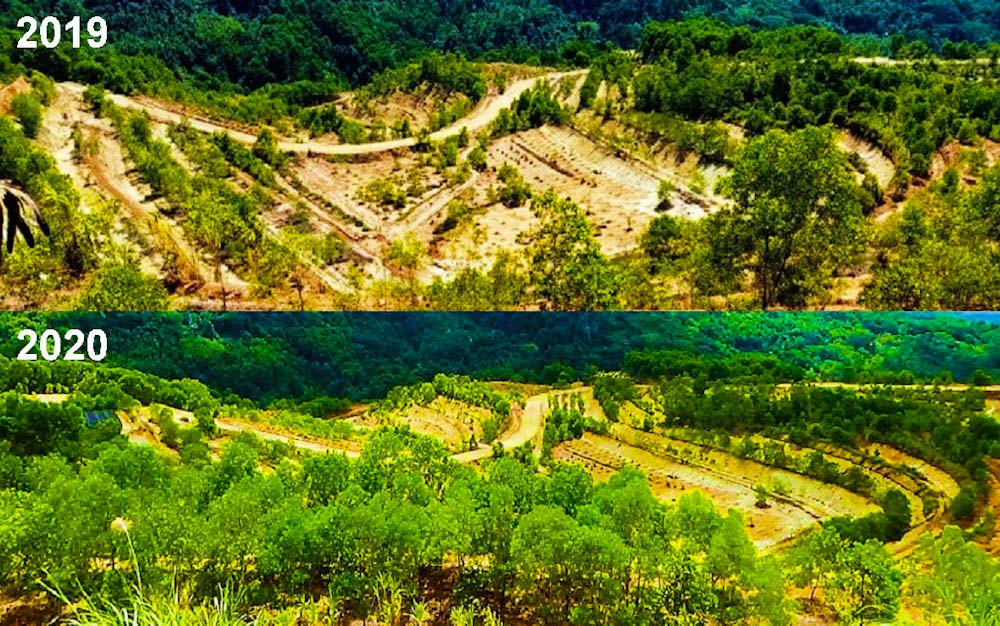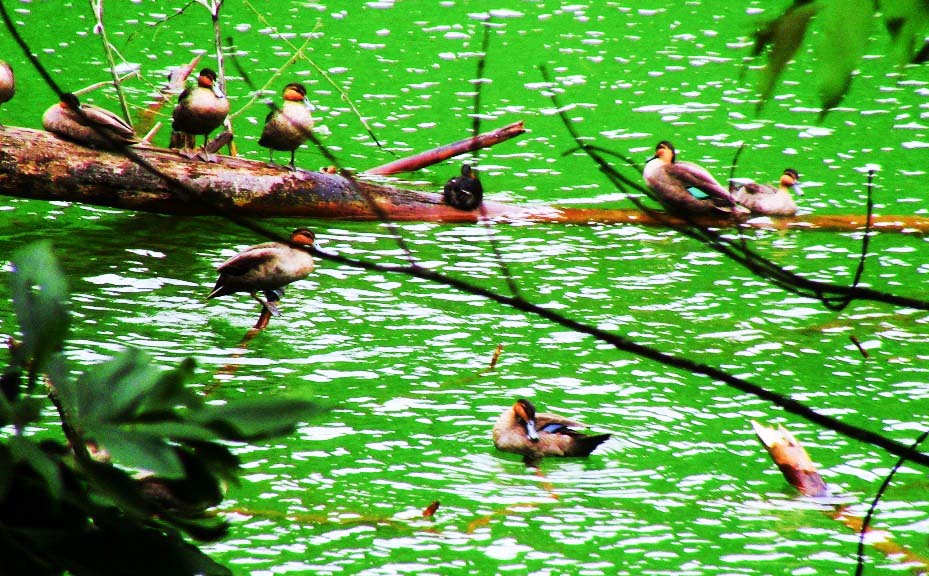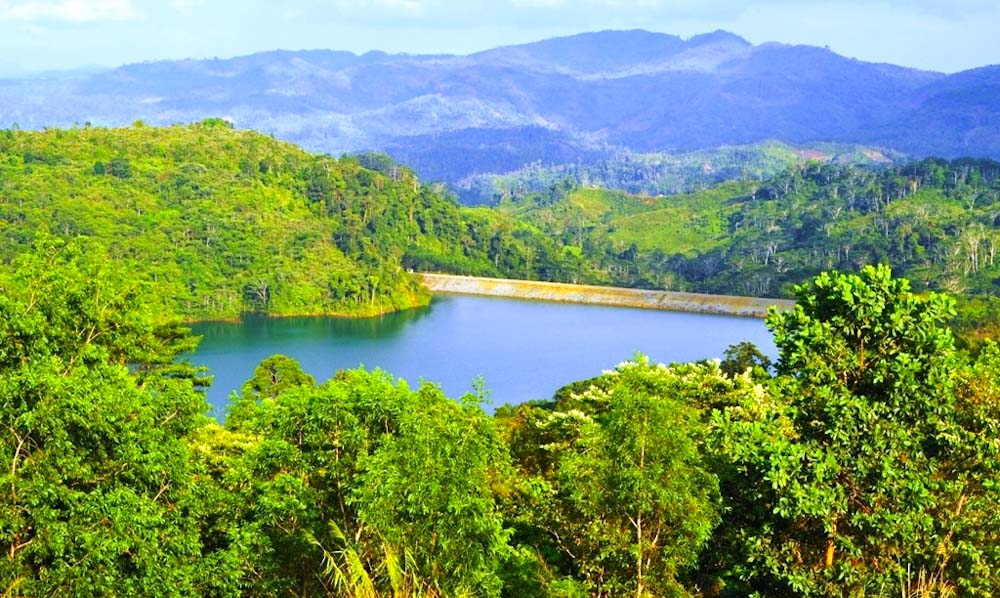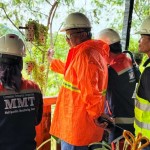-
In a period of nine months, TVIRD’s former mine area in Canatuan has undergone massive re-greening as part of the company’s final rehabilitation program. It has also transitioned the local economy from mining to agro-forestry, which continues to sustain the communities in the area.
-
Wild ducks are permanent residents in TVIRD’s Tailings’ Storage Facility – the “Sulphide Dam.” Some local officials in host Siocon Municipality believe that the presence of this manmade lake could significantly contribute to the town’s coffers by transforming it into a tourist destination once the MPSA is turned-over to the government.
-
Monkeys have permanently settled above the forested area of TVIRD’s Sulphide Dam. On some days, these monkeys can also be seen at the wooded area in nearby Sitio Malusok.
-
Big trees now surround the company’s TSF or Tailings Storage Facility. Year in and year out, ducks are visible here, frolicking in its calm waters during early mornings. Aside from wild ducks, snakes and different kinds of bats and birds reside at the forested area above the lake.
TVIRD Final Rehabilitation activities at 94 percent completion
Siocon, Zamboanga del Norte / June 2020 – Some 25 years ago, TVI Resource Development Philippines Inc. (TVIRD) was the first company licensed to operate under the country’s “new” mining law. Back then, the Mining Act was poised to revitalize the Philippine extractives industry and laid the groundwork not only for developing the country’s mineral resources, but also for the full restoration of mined-out areas once projects are concluded.
Since it brought its gold and silver project on-stream – followed by equally-successful copper and zinc processing operations – TVIRD has joined the ranks of major mining projects in the country. Its maiden project in Sitio Canatuan, Siocon Municipality of this province has effectively put TVIRD on the map and elevated the town into a first-class municipality.
Six years after it concluded Canatuan, TVIRD today has achieved the last phase of its operations in the area – and that is the 94 percent completion of final rehabilitation activities, as confirmed by the Multi-Partite Monitoring Team (MMT) that oversees its accomplishment. Apart from fulfilling its obligation, TVIRD’s final rehabilitation is likewise a true test of the law – further testament that responsible mining is a reality.
Progressive rehabilitation
Environmental rehabilitation, in its strictest sense, did not only begin once the company concluded its mining activities. TVIRD embarked on a wide-scale environmental clean-up and rehabilitation prior to operating in the area, which was in bad shape owing to decades of illegal small-scale mining prior to its entry.
And throughout its operating years, the company’s Environment Department started rehabilitating the denuded parts of Mt. Canatuan as well as mined-out areas turned-over by its Mines Department. By the end of its mining operations in February 2014, TVIRD has planted more than 348,000 trees as part of its progressive rehabilitation. And with an additional 63,000 trees during final rehabilitation, the company has planted a total of 411,000 trees within its Mineral Production Sharing Agreement (MPSA) area, which is part of the Subanen tribe’s ancestral domain.
Fast growing and endemic trees, as well as rubber trees intended for the Subanons’ livelihood were planted. Among these are close to 30,000 rubber trees, which are a good source of future income for the tribe.
Local wildlife
In 2019, CENRO-Siocon conducted its Annual Asian Water Bird Census and travelled to TVIRD’s Tailings Storage Facility (Sulphide Dam) to count the number of wild ducks (Anas Luzonica) found in the area. Ecosystem Management Specialist Muhammad Faz’l Ur-Rahman Werble reported some 950 wild ducks at that time. The previous year’s count registered only 500.
“It means there’s life at the waste disposal facility of the company,” said CENRO team leader Efren T. Cardenas. For two consecutive years, the agency conducted the census of water birds at the Sulphide Dam. Aside from wild ducks, they also found hawks, eagles, squirrels, bats and a variety of snakes, including the Philippine Cobra (Naja Philippinensis).
“It is impressive. I am impressed!” said Absalon Alcorin, Jr., a former TVIRD officer who now works for the Senate of the Philippines. Alcorin who hails from Davao City, oversees key programs and projects in the Zamboanga Peninsula Region. He was with TVIRD in its early days.
“I never thought that the mountain – badly damaged by the illegal miners and turned into a mine pit during operations – is now green. TVIRD really stood by its commitment. It really did amazing rehabilitation work here,” he concluded.
A sketchy history
Mt. Canatuan in Siocon Municipality was a denuded mountain since the late 1980s. it was a picture of heavy devastation as illegal miners from Zamboanga Sibugay and other provinces in Mindanao dug its earth, stole its gold, cut down its trees without replanting, and polluted its creeks and rivers with hazardous chemicals.
The mountain was riddled with hundreds of un-engineered tunnels and shallow ponds that served as makeshift tailings ponds for close to 50 mill plants. These tailings were laced with deadly cyanide, mercury and nitric acid
In 2002, the Mines and Geosciences Bureau (MGB) reported its findings to the Zamboanga del Norte LGU – which prompted the Provincial Government to order the dismantling of illegal mining operations in the village.
‘Cleaning’ Canatuan
Prior to its mining operation in 2004, TVIRD embarked on a year-long “clean-up” campaign to rid the village of hazardous chemicals. Wastes were taken out from the ponds to effectively clean the creeks and other tributaries that lead to Siocon and Lituban Rivers.
By the time it started its gold and silver mining operation, the company has already cleaned Canatuan and identified all areas needing immediate rehabilitation.
Six years after concluding its mining operations and four years into its final mine rehabilitation, Mt. Canatuan is no longer a denuded mountain, nor a picture of devastation and abuse. It is now a picture of hope and a new life for the indigenous Subanons.
*******







